If you want to know about general building requirements or sanitary facilities requirements in building or cinemas design, please click the link.
An auditorium is a room constructed to allow a target audience to hear and watch performances. Auditoria can be discovered in enjoyment venues, community halls, and theaters, and may additionally be used for rehearsal, presentation, performing arts productions, or as a learning space.
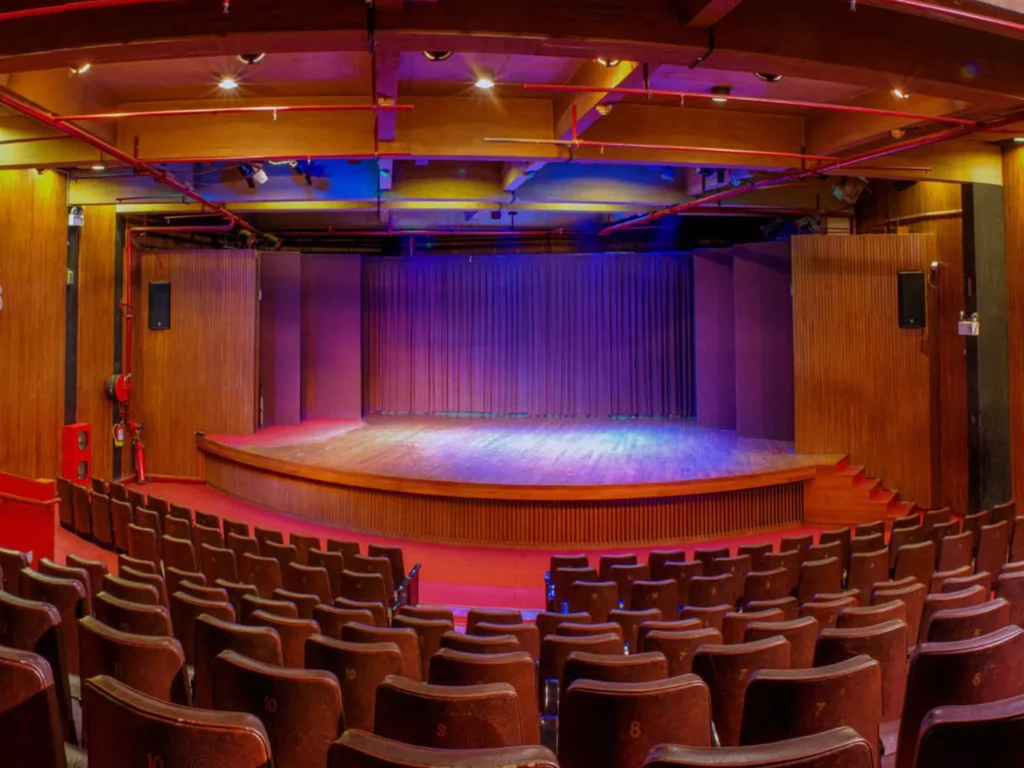
1) Auditorium
- An enclosure covered or open where people can assemble for watching a performance given on the stage is called auditorium.
- An auditorium is a room built to enable audience to hear and watch performances at venues such as theatres.
- An auditorium is a large space that is move of a multipurpose facility.
- A theatre/auditorium is usually a large space that is built to the needs and specifications of the entertainment.
2) Terms used in auditorium
i) Proscenium

- A proscenium is the area of the theatre surrounding the stage opening. A proscenium arch is the arch over this area. A proscenium plane divides the performer and spectators.
ii) House
- House is the main seating area. See the above image.
iii) Gangways

- A passage between two rows of seats. The minimum gangway ought to be 1100 millimeter.
iv) Aisle
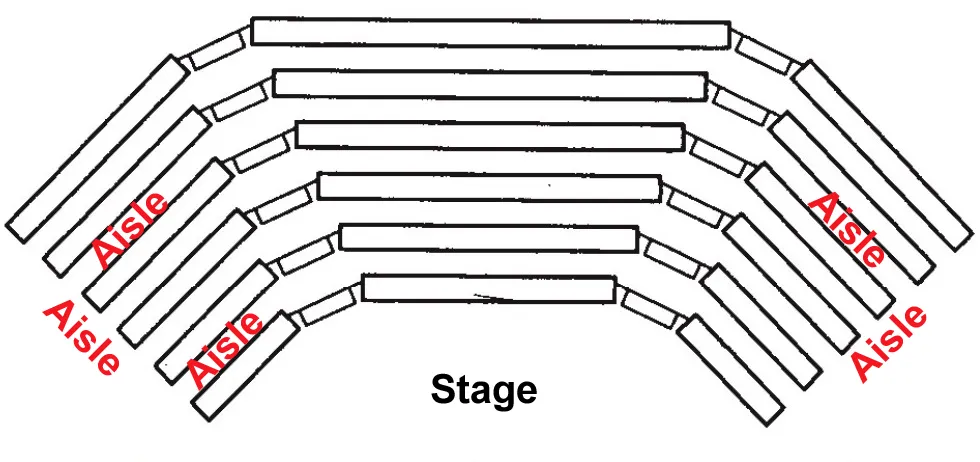
- The walk between every space, row of seats to allow simple passage,(>=45 mm).
v) Drop stage

- A stage floor that moves vertically on the elevator sometimes so one set will quickly replace another.
vi) Tormentor
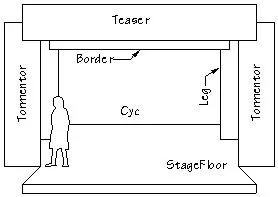
- A curtain or framed structure used directly behind the proscenium at either side of the stage to screen the wings and sidelights from the audience.
vii) Apron
- The part of the stage floor in front of the curtain line. See the above image.
viii) Orchestra pit
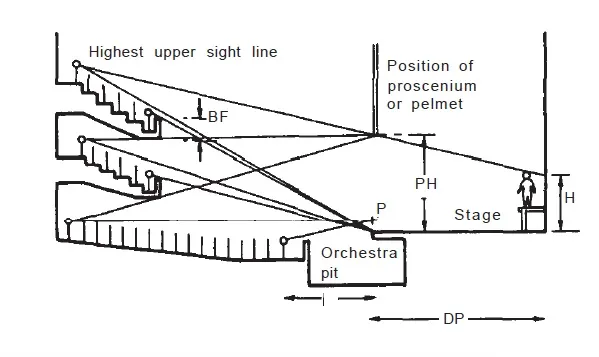
- The space reserved for the musicians usually in front.
ix) Balcony
- A gallery that projects over the main floor of a theatre.
x) Wing
- The platform adjacent to the stage for keeping props.
xi) Box office
- Where tickets are sold.
xii) Cyclorama
- It is the exterior of the backdrop. It is basically a distinction between backstage and main stage.
xiii) Fire curtain
- A curtain or asbestos or other fire-proof material that can be lowered just inside the proscenium arch in the case of fire.
xiv) Green room
- The green room is that the space in a very theatre, studio or similar venue that functions as a waiting room and lounge for performers before and once a performances and through the show once they aren’t working on the stage.
3) Consideration factors for Auditorium design
i) Audience requirements
- Every member of the audience should be able to see and hear clearly whatever is happening on every part of the stage or platform.
ii) Visual limitations
- Visual limitations verify the utmost distance from platform or stage at that the audience is ready to understand the performance and for the performers or speaker to command an audience.
- This distance varies in line with perform kind and therefore the scale of the performance:
- For drama it’s essential to recognize facial features, and therefore the most distance ought to be 20 m measured from the setting line of a proscenium stage or geometric center of an open stage.
- For opera and musicals discerning facial expressions is less critical and therefore the distance will be 30 m.
- For dance the audience must appreciate the complete body of dancers and facial expression: the distance should not exceed 20 m.
- For full symphonic concerts acoustic conditions predominate.
- For chamber concerts acoustic conditions also predominate however visual definition assists achieving an intimate setting.
- For conference speaker and lecturer there are two scales: discerning facial expression, restricted by 20 m; larger scale wherever facial features isn’t considered critical.
- For slide, video, tv and overhead projection visual limitations are determined by their various technologies.
iii) Aural limitations
- This refers to the distances across which speech, singing and music are often clearly heard without the necessity for amplification, and beyond which they can’t.
- For drama, opera and serious music amplification is deprecated; but it’s acceptable for variety and pantomime and essential for rock ‘n’ roll.
- For amplified sound the auditorium requires a dead acoustic with no reflected sound from the platform or stage and limited or no reverberation; loudspeakers are positioned to supply full and even coverage of the audience.
- The volume and quality of the unamplified sound depends on the quantity, shape, size and internal finishes of the auditorium, and on its resultant reverberation time. It is therefore impossible to get down limits as for visual appreciation.
iv) Levels in the auditorium
- With a single level only, the pitch of the rake requires particular attention to realize a way of enclosure.

- Seating capacity within aural and visual limitations are often increased by the addition of one or more balconies within the general permissible volume of the auditorium.
- Similarly, boxes, side galleries and loges are often added to the side walls, especially within the case of the proscenium format.
v) Number of seats in a row
- With traditional seating the maximum number is 22 if there are gangways at both ends of the row, and 11 for gangway at one end. Thus in all but the smallest auditorium the gangways divide the seating into blocks.
- Rows with more than 22 seats are permitted if the audience is not thereby imperilled.
- A maximum of 16 seats per aisle. 25 seats per aisle is permissible if one side exit door of 1 m width is provided per 3-4 rows.

- The term ‘continental seating’ is used for rows of seats with an increased back-to-back dimension extending the width of the auditorium with exits at both ends. This arrangement is only appropriate to proscenium stages.
vi) Row to row spacing
- Spacing is controlled by the clearway between the leading edge of the seat (in an upright position, if tippable) and the rear of the back of the seat in front, as shown in figure.

- For traditional seating the minimum clearway for people to pass along the row is 300 mm and this dimension increases with the number of seats in a row.
- For continental seating the clearway is not less than 400 mm and not more than 500 mm.
- Legislation also dictates the minimum row to row dimension at 760 mm this is usually not adequate and the minimum should be 850 mm to 900 mm. for traditional seating.

vii) Gangways
- As gangways are essential escape routes, their widths are determined by the number of seats served. The minimum is 1100 mm.
- They can be ramped up to 10%, but only 8.5% if likely to be used by people in wheelchairs.
- If the seating rake is steeper, gangways must have steps extending the full width and these must have consistent treads and risers in each run.
- This means that the row to row spacing and row rise should be compatible with a convenient gangway tread and riser and this in turn means that the shallow curve produced by sight line calculations should be adjusted to a straight line.
viii) Seating geometry
- Seating is usually laid out in straight or curved rows focused towards the platform or stage.
- Further forms are the angled row, straight row with curved change of direction and straight rows within emphasized blocks of seats.

ix) Seating density
- Seats with arms and tippable seat can occupy a space as small as 500 mm wide (less for seats without arms) with a row to row dimension of 760 to 900 mm but can be as large as 750 mm wide by 1400 mm, as shown in the figure.
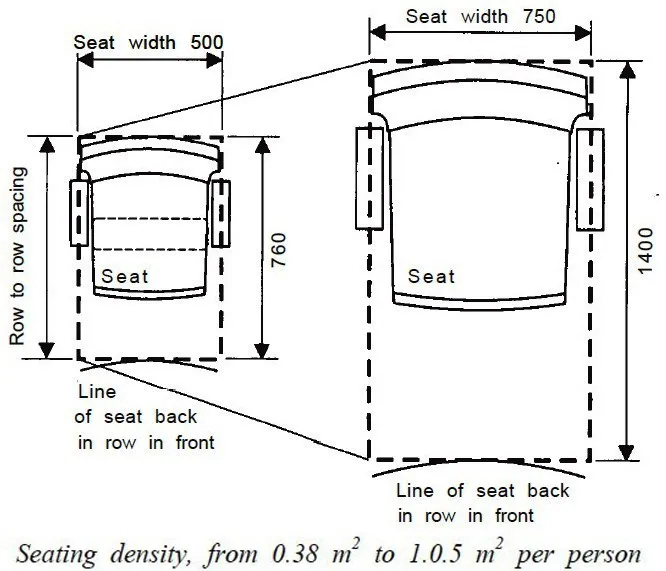
- The area per seat therefore varies between 0.38m2 and 1.05m2. Increased dimensions reduces seating capacity.
- Minimum dimensions as laid down by legislation offer a low standard of comfort and should not be taken as a norm, but the social cohesion of the audience may be lost if the standards are too high.
Size of auditorium
- An area of at least 0.5 m2 per spectator is to be used for sitting spectators.
- This number is derived from a seat width x row spacing of at least 0.45m2 per seat, plus an additional minimum of 0.5m x 0.9m i.e. approximately 0.05m2 per seat.
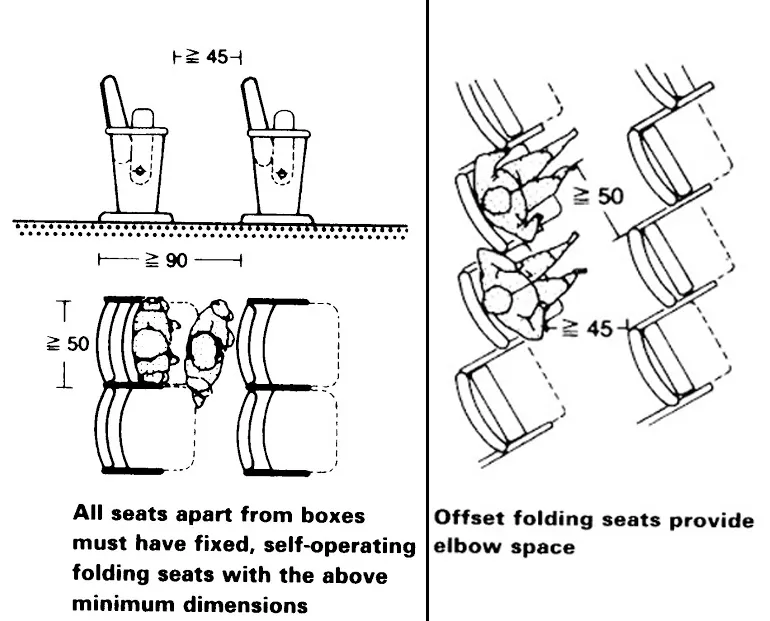
- In conference halls where writing space is required, lower densities are inevitable, as shown in the figure.
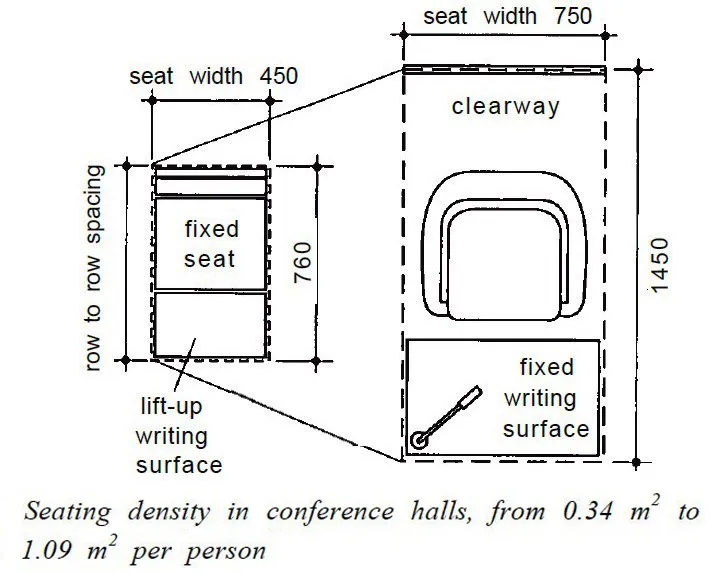
x) Sightlines for a seated audience
- For every member of the audience to have an uninterrupted view of the platform or stage over the heads in front and clear of overhangs the section and plan of the auditorium need to conform to certain limitations set by vertical and horizontal sightlines.
Vertical sightlines
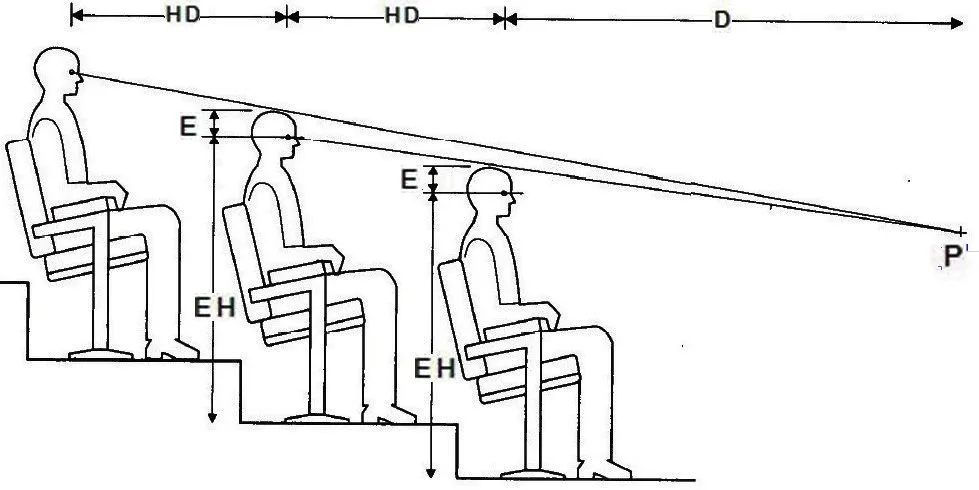
- P Lowest and nearest point of sight on the platform or stage for the audience to see clearly.
- HD Horizontal distance between the eyes of the seated members of the audience, which relates to the row spacing and can vary from 760 mm to 1150 mm and more.
- EH Average eye height at 1120 mm above the theoretical floor level: the actual eye point will depend on seat dimensions.
- E Distance from the centre of the eye to the top of the head, taken as 100 mm or 120 mm as a minimum dimension for the calculations of sightlines. For assurance that there is a clear view over the heads of those in the row in front this dimension should be a least 125 mm.
- D Front row of seats: the distance from point P to the edge of the average member of the audience in the front row.


- Elevation of seating (gradient) in the auditorium is obtained from the lines of vision. Such lines are valid for all seats in the auditorium (stalls as well as circles).

- The rows of spectators should be formed in a circular segment with respect to the stage, not just for better alignment but also to achieve better mutual perception (feeling of integration).
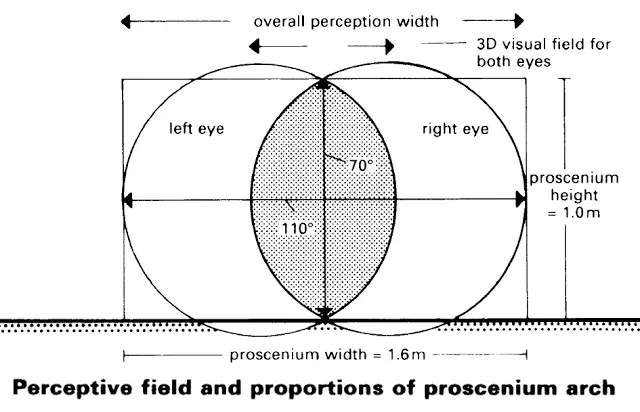
- The proscenium height should first be determined. The ratio in a stall’s theatre of proscenium height to width should be 1:6. The golden section, or the physiological perception field, is included in this.
Cross-gangways
- With cross-gangways the line of the auditorium rake must continue so that the audience can see the performance area above the gangway as below.
- With stepped rows there requires a handrail to the upper side of the gangway and, if a steep rake, a handrail to the lower side. See figure below.

Horizontal sightlines
- Given a particular size and shape of the platform or stage, horizontal sightlines limit the width of the seating area in the auditorium. This is more critical with the proscenium stage and with film, video and slide projection.
- Without head movement, the arc to view the whole platform or stage on plan is 40° from the eye, as shown in the figure.
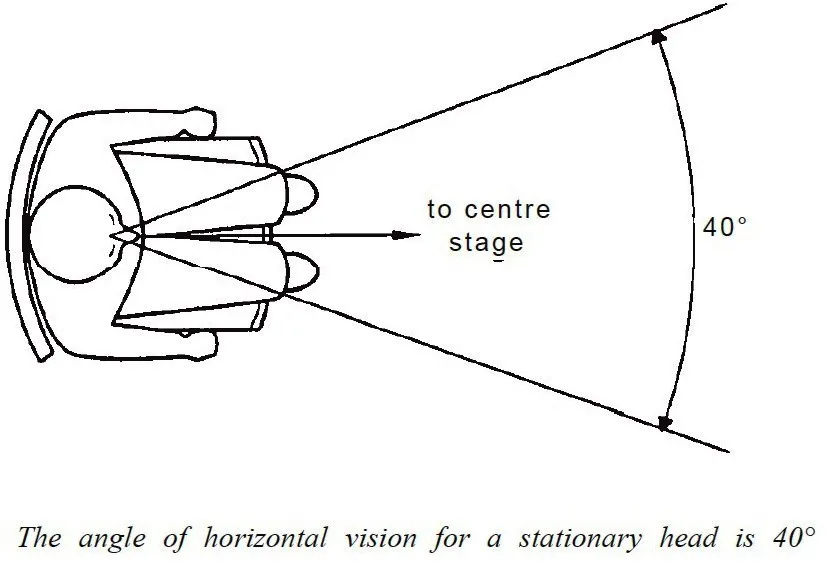
- Debatable is an acceptable head movement, where the seat is focused away from the platform or stage, such as with side galleries requiring the head to be turned by the member of the audience, as shown in the figure.
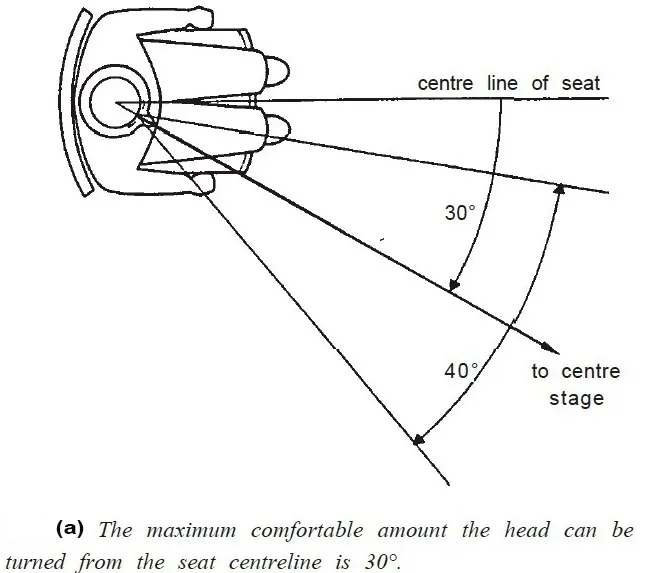

- The horizontal sight line of the performer may also need consideration, as shown in the figure.

4) Proportions of auditorium
- These are obtained from the spectator’s psychological perception and viewing angle, as well as the requirement for a good view from all seats.
- Good view without head movement, but slight eye movement of about 30°.
- Good view with slight head movement and slight eye movement approx. 60°


- Maximum perception angle without head movement is about 110°, i.e. in this field everything which takes place ‘between the corners of the eyes’ is perceived. There is uncertainty beyond this field because something may be missed from the field of vision.
- With full head and shoulder movement, a perception field of 360° is possible.
5) Proportions of stage
i) Stage forms
- There are three stage forms: full stage, small stage and set areas.
Full stage
- More than 100 m2 of stage area. Stage ceiling more than 1 m above top of proscenium arch.
- An essential feature of a full stage is an iron safety curtain which separates the stage from the auditorium in the event of an emergency.
Small stage
- Area no more than 100m2 , no stage extension (secondary stages), stage ceiling not more than 1 m above top of proscenium. Small stages do not require an iron safety curtain.
Set areas
- Raised acting areas in rooms without ceiling projection. The peculiarity with set areas is in the regulations with respect to curtains and scenery. They affect the operation, not the planning, of set areas.
- Experimental auditoria fall within the set area definitions.
ii) Stage proportions
- Stage proportions are developed from the lines of vision from the auditorium. The stage area is the playing area plus walkways (around the back of the stage) and working areas.
- The principles design of a traditional full stage. As shown in the figure below.


- Mobile set areas are formed from height-adjustable platforms or lifting podia. Variable shapes are achieved by splitting the area into individual elements. Basic dimensions 1 m x 2m


iii) Stage ventilation
- Means should be provided for ventilating smoke and hot gases resulting from fire on the stage, e.g. provision of haystack lantern light or fire ventilator sited in highest point in roof over stage and as near to centre of stage as is reasonably practicable. An additional fresh air inlet may prove effective.
6) Other consideration factors for Auditorium design
i) Wheelchair location
- Regulations require a minimum of six places for wheelchair users, or 1/100th of the audience capacity, whichever if the greater.
- Their location as discrete areas can be at the rear, front, side or within the seating, as shown in the figure.

- Wheelchairs can be centrally positioned by forming a bay off a cross-gangway.
- A wheelchair user should be able to sit with a party of friends not in wheelchairs, as shown in the figure.

- Sightlines from the wheelchair should be checked, as should the sightlines of those audience members behind. Some wheelchair users can transfer into auditorium seats.
ii) Handrails
- Balcony handrails, as shown below figure, are specified by legislation covering height, width and structure: they must also not interfere with sightlines.

Note –
- The minimum balcony handrail height (BH) is set by legislation at 790 mm in front of fixed seating and 1100 mm at the ends of gangways.
- Balcony fronts are used to support performance lighting and need socket outlets connected to stage lighting controls

Note –
- Simpler front for side galleries with minimum clearway allowing the audience to lean on the handrail.
- This front is removable as part of a flexible auditorium
iii) Means of escape
- The aim is for all in the auditorium to be able to escape to a place of safety within a set period of time. The escape route is from the seat, along the clearway and gangway, and through exit doors immediately, or through an enclosed corridor, to the place of safety.
Travel distance
- The maximum travel distance from seat to exit within the auditorium is determined by the need to evacuate from each level of the auditorium within 2½ minutes.
- For traditional seating the maximum travel distance is 18 m measured from the gangway, for continental seating 15 m from any seat.
Exits
- From each level of the auditorium two separate exits must be provided for the first 500 seats with an additional exit for each further 250 seats.
- As image shown in below gives the minimum total of exit widths required by legislation. Each exit from the auditorium must lead directly to a place of safety.

Exit routes
- The route must be a consistent width the same as the exit. There must be no bottlenecks and all doors within the route must open in the direction of escape.
- Routes within the building should have fire-resistant enclosures. There are special requirements for all doors opening onto fire escape routes.
Stairs
- Staircase flights should have at least two risers and not more than 12. All treads should be 300 mm and risers 150 mm.
Ramps
- Wheelchair users should be provided with flat or ramped escape routes which may be separate from other routes. Ramps should not be longer than 4.5 m or steeper than 8.5%.
iv) Circulation
- While gangway lengths and widths are calculated as part of the fire escape route, they also provide the circulation through the auditorium, with possible additional gangways from the audience entry points to individual rows and seats.
v) Floors
- The floor of the auditorium is an acoustic factor in the success of an auditorium. Some venues now dispense with carpets as plain wooden floorboards offer a better acoustic for orchestral music.
- Consideration should be given as to whether the auditorium floor should be flexible to account for acoustic variability.
vi) Sound insulation from outside noise sources
- The standards are expressed as Noise Rating (NR). To achieve the appropriate rating auditorium design may require:
- Isolation of the auditorium structurally
- Sound locks to all doors at point of entry
- Services acoustically sealed, and
- Noise reduction to air conditioning/heating/ventilation system.
vii) Air conditioning, heating and ventilation
- The design depends on the internal standards required in the auditorium, the thermal insulation of the enclosure and on the external climatic conditions.
- Ventilation needs to provide fresh air at a rate of change to achieve comfort conditions: rates are set down by legislation and include a proportion of recycled conditioned air which vary locally.
- A common condition is a minimum air supply per occupant of 8 litres per second, 75% of outside air and 25% recirculated.
- Extract ductwork can be at ceiling level and under balconies with supply below the seating.
- Plant should be remote from auditorium to avoid noise transmission.
viii) Lighting
- There are six different requirements for auditorium lighting.
Performance lighting
- For theatre, opera and dance performance lighting is an integral part of the staging of productions, with lighting positions not only on the stage but also within the auditorium at ceiling level, on side and rear walls and balcony fronts.
- For classical music and serious jazz sufficient lighting for the performers to see their music and the conductor (if any), and for them to be seen by the audience is usually all that is required.
- Similar lighting is required for the platform at conferences.
- Pop music requires as complex lighting as for drama and opera – perhaps even exceeding that with elaborate effects.
House lighting before and after performance and during intervals
- Illumination to enable the audience to move around, find their seats and read programmes; decorative lighting to emphasis architectural features.
- This form of lighting will also be required during conferences.
House lighting during performance
- For cinema lighting is only for exit signs and escape routes. For the latter, small lights just above floor level have advantages in not obscuring the screen and being most effective in smoke-logged conditions.
- For theatre a slightly higher level of illumination may be used, particularly if the performance demands a contrast with a time of almost total darkness.
- For classical music it is now usual to have sufficient lighting for near-normal vision and following scores. Pop music may nowadays require house lighting as sophisticated as performance lighting, with strobe and laser facilities.
- Certain lighting is required during performances to ensure safety in emergency, particularly the statutory exit signs.
- Other lighting may be required to come on automatically in emergency situations; this may work off a separate protected supply. Alternatively, each item can incorporate a battery and be programmed to come on when a failure in the mains supply is detected.
House lighting at other times
- It should not be forgotten that the seating area will also require a working level of lighting for cleaning, maintenance and probably during rehearsals and auditions.
Front-of-house lighting
- Escape routes have to be adequately lit at all times, during performances as well as before and after. Foyers, bars and ticket offices require careful lighting design to enhance their attraction.
Backstage lighting
- Corridors are escape routes for the performers and service staff, and must be kept illuminated whenever the building is occupied.
- Dressing rooms and workshops will have normal lighting for such facilities, and may be fitted with proximity detectors to ensure that lights are not left on when the rooms are unoccupied.
ix) Fire protection
- Fire precautions should be discussed with the local fire authority and with fire insurers. However, it is important to consider four other factors:
Preventing fires occurring
- Non-combustibility of materials including finishes and seating
- Protection of electrical circuits
- Care with lighting, and
- Separation of hazardous processes such as scene-painting.
Detecting them early when they do occur
- Smoke and heat detectors backstage, in auditorium and all voids
- Alarms connected to the automatic detector system and central indicator panel, and possibly direct link to local fire station. These should be visual (flashing light) in auditorium and not audible.
Preventing them spreading
- Enclosing walls and floors to be fire-resistant
- Self-closing fire doors to openings
- Either a safety curtain to the stage area or special on-stage precautions.
Facilitating extinguishing
- Hose-reels
- Portable extinguishers
- Automatic sprinkler systems backstage (not allowed over seating areas).
x) Ceiling zone
- Functional requirements cover:
- Acoustics: profiled reflector panels and possible adjustable diffusers. For non-amplified music, reflectors also over concert platform
- Lighting: bridges for access and support for auditorium lighting, working lights and emergency lighting as well as performance lighting
- Ventilation: air ducts and plenums, diffusers, noise attenuation and monitoring equipment, supporting hangers and means of access for servicing
- Production requirements: for operas, dance musicals and drama, a grid and pulley suspension for suspending scenery over forestage, including access by technicians
- Fire control: detection system in voids and fire dampers in ducts and
- Structure: support for roof, ducts, lighting bridges, etc.
very good desgin
You are just great yh.
….thumbs up! Great job